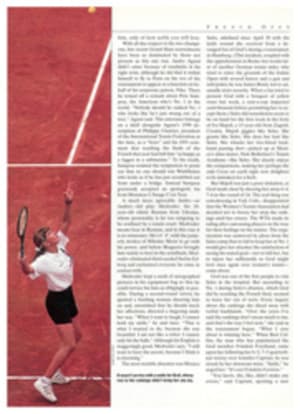
The High and the Mighty
The wooden sign hanging above David Levin's driveway is emblazoned with foot-high letters that read BALLOON RANCH. The stained-glass window on the front door of his house, near Boulder, Colo., bears the image of a balloon in flight. The foyer of the house is crammed with ballooning trophies; the living room is a museum of ballooning posters; and the kitchen is chock-a-block with balloon dishes, balloon mugs and balloon-shaped baking tins.
"You can't be half involved in ballooning," says Ruth Wilson, a former Australian hot air balloon champion and a close friend who is visiting Levin and his wife, Roberta. "It's a sport dependent on emotion rather than athleticism; you either love it and make it the centerpiece of your life, or you leave it." Levin, who keeps six balloons in his backyard "balloon barn" and another in Salzburg, Austria, for European competitions, is less than subtle about where his feelings lie. But if anyone has the right to such an ostentatious display, it is Levin. Last fall in Europe, he won the Coupe Aeronautique Gordon Bennett, ballooning's Indy 500, as well as the World Gas Balloon Championship, in Obertraun, Austria; previously, he had been victorious in both the U.S. hot air nationals and the world hot air championship, becoming the first pilot to win all four of ballooning's major events.
"Balloon competition scares the hell out of mc," Levin says. "On competition days I wake up with stomach cramps and diarrhea; it's exactly like stage fright. But when I do well—boy! That's the best mood I ever get in; there's nothing as exhilarating as winning a balloon race. I guess that's why I do it."
For Levin, ballooning was love at first flight. He first took to the sky in 1975, the year he graduated from Boston University law school, and shortly after his childhood friend Link Baum had the preposterous idea of starting the world's first ballooning resort. Levin, looking for any excuse to avoid legal work, was all for it. Baum located some property in the remote San Luis Valley in southern Colorado, and in August 1976, Levin and Baum established the Balloon Ranch, a resort that offered guests frequent balloon flights. "From May to October, I flew almost every day," says Levin. "It was magical—I felt like the Wizard of Oz and Phileas Fogg and Babar the Elephant all rolled into one. They say you can't stay young forever, but I realized you can stay immature."
Profits, however, were less than magical, and Levin left the ranch and moved to Boulder in 1981, bringing with him a few balloons and the sign that now hangs over his driveway. While managing the ranch Levin had begun entering balloon events, and the move to Boulder allowed him to devote more time to competitive piloting.
Since the first hot air balloon was launched, in France in 1783, the basics of flying one have remained unchanged: For an ascent, heated air is pumped into the balloon; for a descent, the hot air is released through a vent at the top of the balloon. A pilot is strictly at the mercy of the winds, and a time-honored method of determining wind direction is to spit over the side of the balloon's gondola. The principles of gas ballooning are likewise unchanged; the major difference between gas and hot air ballooning is that the quantity of gas in a balloon remains fixed; cold air causes the gas to contract, lowering the balloon; ballast, usually sand, is dumped over the side to make it rise again. Gas balloons, which can fly for longer periods of time, are more common in Europe; hot air balloons, which are less expensive to operate, are more popular in America.
Levin is one of the few pilots who wins contests in both types of balloons. Whether hot air or gas, meets consist of a series of precision-flying events, called tasks. There are more than a dozen types of tasks, but all are variations on the same theme—drop a marker (a beanbag with a tail) from the balloon onto a designated target, usually the intersection of two roads. The pilot whose bag lands closest to the center of the intersection is awarded 1,000 points; other competitors, depending on how far their marker is from the winner's, receive fewer points. A world championship can last more than a week and often has 20 or more tasks. The pilot must complete two flights a day, weather permitting. The sight of 100 balloons simultaneously departing for a task, looking like a flood of multicolored, inverted raindrops, is one of the most stirring in all of sport.
There is another type of contest, a distance competition. The Gordon Bennett, first held in 1906, is the most prestigious of these. All the balloonists take off from the same place, and whoever goes the farthest before landing is the winner. When Levin won the '92 Bennett—the first American to do so since 1932—he took 44 hours to fly 645 miles from Stuttgart, Germany, to Przemysl, Poland.
"Time and speed," Levin says, "are never factors. Nor is physical coordination. The best pilots have a feel, an innate understanding of how the wind will move them. When you are flying well, it is like meditating; firing the burner acts as your mantra." Levin, 45, has a marathoner's physique, lithe and fluid, with a mop of curly black hair, tinged with gray above the ears, a large mustache and deeply tanned skin. He is, by all accounts, fiercely competitive—some have even said too much so.
"David is one of the only people I know who thrives off the competition," says Bruce Comstock, six-time U.S. hot air champion. "When I told him that I was retiring from competition, he told me he plans to race until he can't climb into the basket."
Levin is obsessive about prerace preparation. He usually arrives at a competition a week in advance to study the terrain. For this year's U.S. Hot Air Balloon Nationals, scheduled for the first week in August in Middletown, Ohio, Levin has already analyzed all the competition map's intersections—there are more than 200 of them—and noted not only where all the cows are (it is against contest rules to select a target within 500 feet of livestock) but where they might be on competition day. During meets, he forbids his ground crew to drink alcohol and has been known to dismiss someone the first time he arrives late. "I tell my crew, 'We are here for one reason and one reason only—to win,' " says Levin. "When we're all finished, then we can celebrate."
As ballooning competition has become more intense (a decade ago there were 30 U.S. events a year and only a few dozen pilots, now there are more than 100 events sanctioned by the Balloon Federation of America and 400 competitors), so too has Levin. But despite his many victories, 15 years of competition have netted him only $70,000 in prize money.
"The only way to make a small fortune in ballooning," says Levin, "is to start with a large one." An inheritance from his grandfather has allowed Levin to devote himself to the sport, and for Levin, as for most top pilots, money is not the motivating factor. "Ballooning has allowed me to travel the globe," he says. "I've flown out of a bullring in Spain; I've had children running after me through the streets of French villages; I've been mobbed by autograph-seekers in Japan; I have friends in almost every country in the world."
Still, Levin is not satisfied. A new type of balloon, called a Roziere, is becoming increasingly popular among top-level balloon pilots—it combines heat and gas, and is able to stay aloft much longer than the traditional models—and Levin is itching to build one. "Even though there's only a handful of Roziere pilots, there's already a Roziere world championship," he says. "And because it exists, I need to go out and win it."
PHOTO
CARL YARBROUGH
No legal eagle, Levin decided he would forgo law and become a competitive pilot.
PHOTO
CARL YARBROUGH
When Levin flies one of his hot air balloons, things heat up before takeoff.
Michael Finkel is a free-lance writer who lives in Bozeman, Mont.

